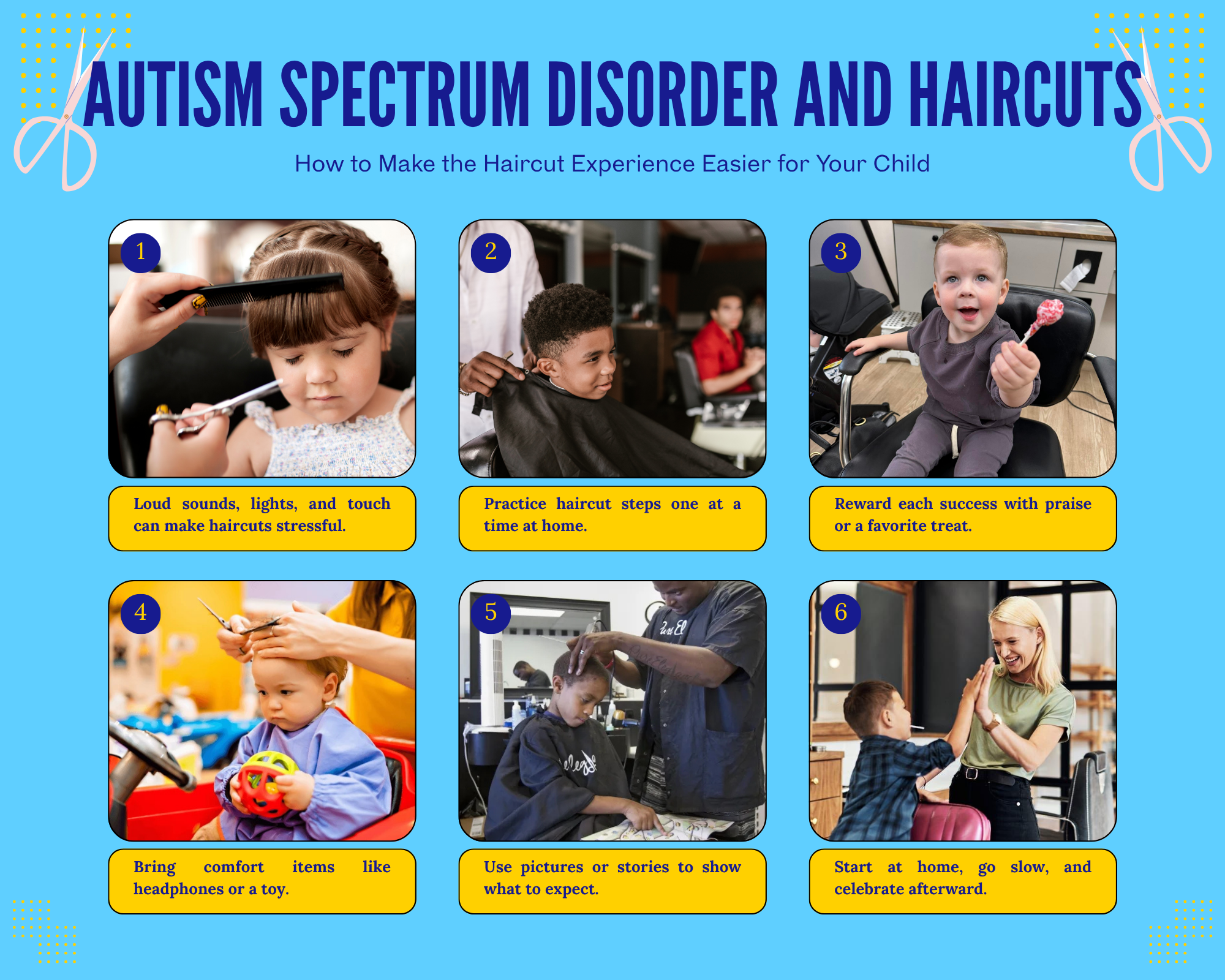Autism Spectrum Disorder and Haircuts: How to Make the Experience Easier for Your Child
Haircuts can be tough for many kids, but for children with autism, it can be especially overwhelming. From the buzzing of clippers to the feeling of falling hair, the experience can cause significant sensory distress. However, with proper preparation, understanding, and support, autism haircut challenges can be managed more effectively.

Why Are Haircuts Challenging for Children with Autism?
Many children on the autism spectrum face sensory processing difficulties, making everyday experiences more intense. Haircuts often trigger these sensitivities due to:
- Loud noises from clippers or hairdryers
- The feeling of falling hair on skin
- Unfamiliar textures or tight clothing like capes
- Sudden or unexpected touches
- Bright lights and salon sounds
- The difficulty of sitting still for long periods
Understanding these triggers is essential in creating a more supportive haircut routine. Learn more about how ABA therapy supports sensory processing in children with autism.
Strategies to Make Haircuts Easier for Autistic Children

1. Break the Process Down (Task Analysis)
ABA therapy techniques like task analysis are especially useful for autism haircut preparation. Break the haircut into small, manageable steps like:
- Walking into the salon
- Sitting in the chair
- Wearing the cape
- Hearing scissors or buzzer
- Feeling the touch of a comb
- Using a hairdryer
Practice each step individually at home to build comfort.
2. Use Positive Reinforcement
Reward progress with praise, snacks, favorite toys, or screen time. Positive reinforcement creates a strong association between haircuts and pleasant experiences. For more ideas, explore our guide on helping your child manage their emotions.
3. Use Comfort Items
Let your child bring something familiar—a stuffed animal, blanket, or noise-canceling headphones—to provide emotional support during the haircut.
4. Visual Schedules and Social Stories
Create a visual schedule showing each step in the haircut process. Use simple illustrations or photos. A social story can explain what will happen in reassuring, relatable language.
5. Adapt the Tools and Environment
If the buzzing noise of clippers is too much, use scissors instead. Use a soft makeup brush to clear hair from the neck or shoulders. Choose a lightweight cape that doesn’t touch the neck tightly.
6. Choose a Sensory-Friendly Hairdresser
Seek out barbers or salons that offer sensory-friendly haircut options. Look for stylists trained in working with neurodivergent children. Many cities have autism-friendly salons or quiet hours.
7. Start with At-Home Haircuts
A familiar setting helps reduce stress. At-home haircuts allow your child to feel more in control. Once they’re more comfortable, gradually introduce them to salon environments.
8. Allow Breaks and Distractions
Don't force the entire haircut in one sitting. Offer breaks if needed. Let your child watch their favorite show or listen to calming music during the session.
9. Build Post-Haircut Rituals
Celebrate each successful haircut with a treat, outing, or favorite activity. Recording your child talking about their positive experience can offer reassurance before future appointments.
How ABA Therapy Can Help with Haircuts
Applied Behavior Analysis (ABA therapy) helps children with autism manage sensory triggers, create coping strategies, and learn adaptive skills for real-life situations. At Early Autism Services, we can develop individualized ABA therapy services to improve daily life skills, including grooming and personal hygiene routines like haircuts.
Final Thoughts
Haircuts don’t have to be stressful for children with autism. With preparation, patience, and the right strategies, your child can develop confidence and gradually become more comfortable with grooming routines. Every small win counts—and we’re here to help you every step of the way.
Need Help Supporting Your Child’s Sensory Needs?
At Early Autism Services, we specialize in helping children aged 1–10 build real-world skills through compassionate, expert ABA therapy. Request a free consultation today to learn how we can support your child’s journey.
Explore More

Holiday Preparation Tips for Children with Autism: Maintaining Routines and Managing Travel Stress
Make your holidays smoother and more enjoyable with a little planning. Keep routines steady, prepare travel essentials, create sensory-friendly spaces, and set expectations for gatherings. With gentle communication and flexible supports, your family can enjoy a calmer, more meaningful holiday season.

How to Choose Sensory-Friendly Winter Clothing for Your Child with Autism
Sensory-friendly winter clothing can make cold-weather dressing easier for children with autism. Soft fabrics, tagless designs, and gentle layering reduce discomfort and support smoother routines. With small strategies like offering choices, practicing indoors, and creating predictability, parents can ease dressing challenges. Early Autism Services provides personalized support to build comfort and confidence.

Sensory-Friendly Winter Activities for Children with Autism
Winter can be challenging for children with autism due to sensory sensitivities and routine changes. This blog offers sensory-friendly indoor and outdoor activity ideas, ABA strategies to maintain routines, and clothing and comfort tips. With thoughtful planning and EAS support, families can help children stay calm, engaged, and happy throughout the winter season.

